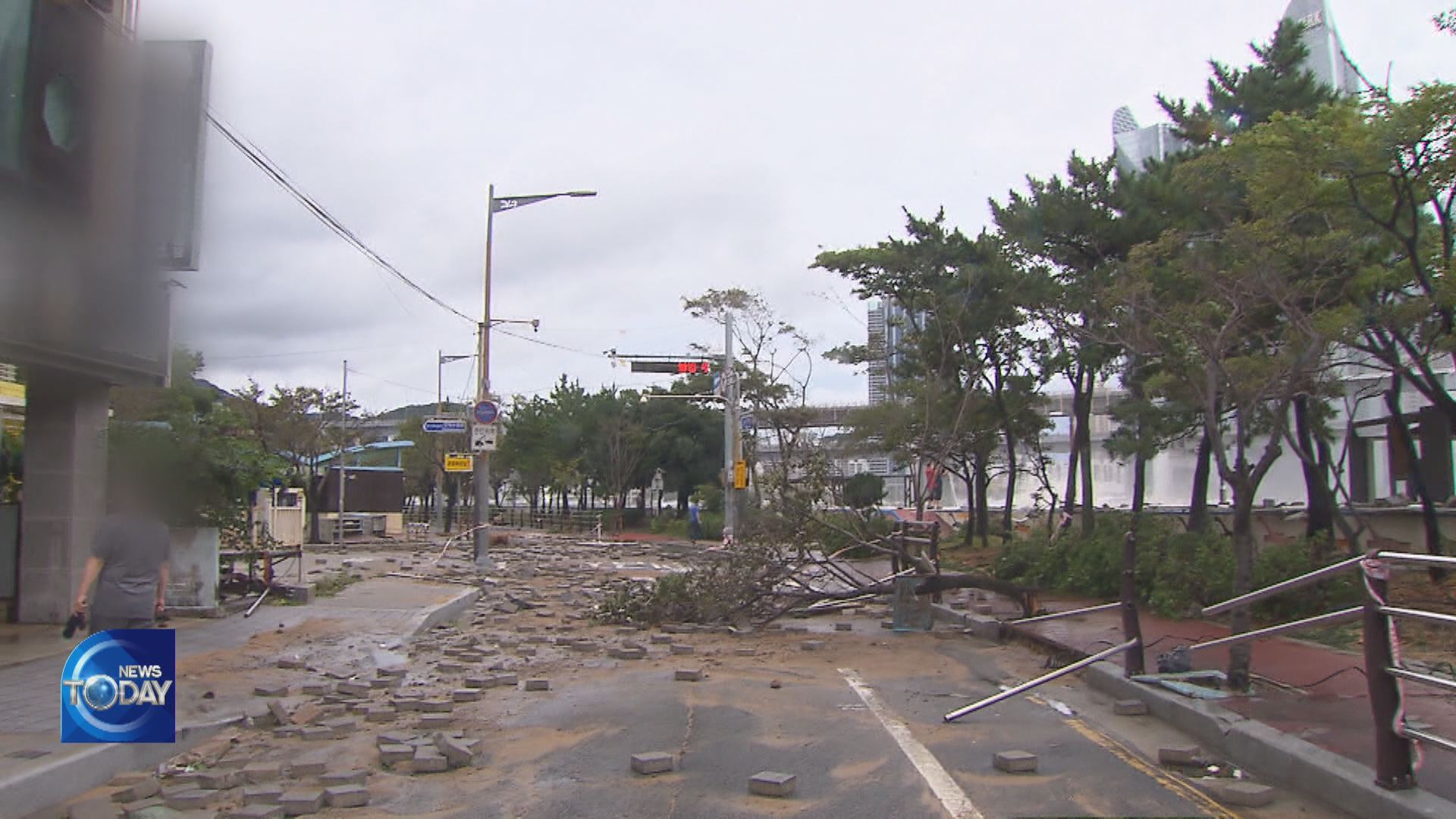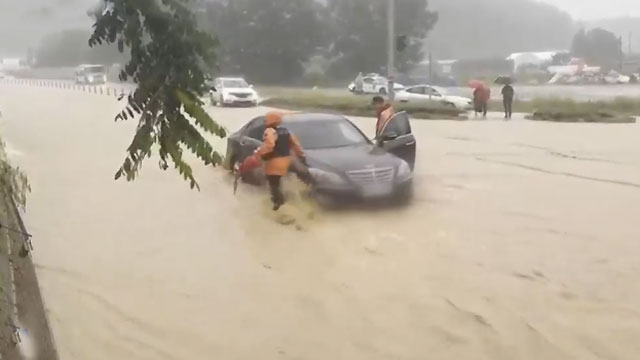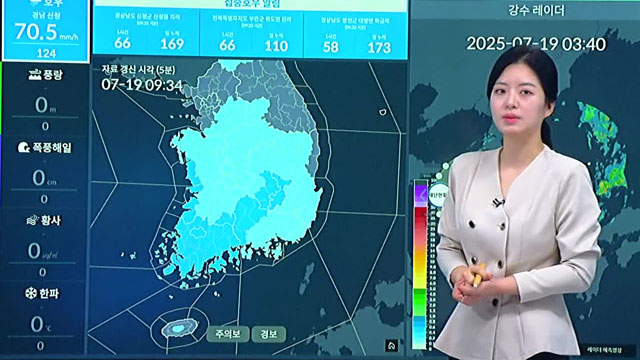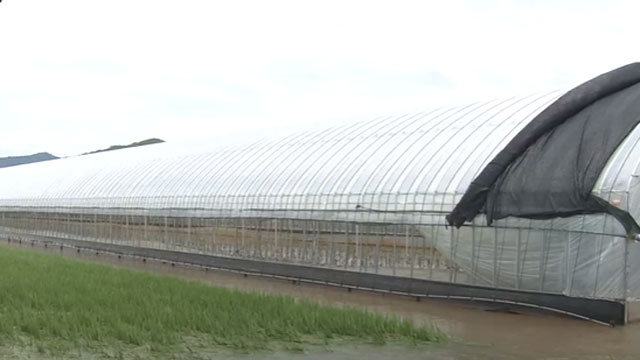CLIMATE CHANGE AFFECTING DISASTERS
입력 2022.09.30 (15:14)
수정 2022.09.30 (16:45)
읽어주기 기능은 크롬기반의
브라우저에서만 사용하실 수 있습니다.
[Anchor Lead]
Typhoon Hinnamnor, which made landfall in Korea in an unusual way, caused massive damage. An analysis shows if Korea fails to cut its carbon emissions, more powerful typhoons could hit it in the future, and their impact will be large enough to cover the entire country. Here's more on how climate change affects disasters.
[Pkg]
Typhoon Hinnamnor brought record precipitation of 111mm per hour. It caused flash floods and destruction in no time. Just two weeks later, Typhoon Nanmadol also wreaked havoc on Korea's southern region while making its way through Japan. Both originated at the north latitude of over 20 degrees, evolving into super strong typhoons. It's also quite unusual that they maintained their strength while moving northward. Half of the typhoons that hit Korea in the past decade were of the "very strong" category. One-fourth of them were "super strong.“
[Soundbite] Prof. Cha Dong-hyun(Ulsan Nat’l Institute of Science and Technology) : "Water temperature is rising due to global warming, especially in mid-latitude areas, typhoons are becoming more powerful."
The primary factor lies in rising water temperature. A forecast of the KMA and four domestic universities shows if the current "high carbon" scenario plays in typhoons' central pressure may go down to 933 hPa. That's unprecedented strength. The median latitude where typhoons occur may rise from the current 18 degrees to 22 degrees the north latitude.
[Soundbite] Lee Woo-seop(APEC Climate Center) : "When typhoons originate up in the north, Korea has less time to prepare. That’s why they are more dangerous."
They also forecast the number of typhoons passing through the West Sea could increase by 85 percent. It means the entire Korean Peninsula will fall into the dangerous semicircle, resulting in serious damage.
[Soundbite] Lim Lee-ja(Environment and Labor Committee) : "We need a system that can monitor, predict and analyze the impact of climate on Korea in a comprehensive way and provide this information to the public."
Typhoons serve as a warning that climate change is a vicious cycle leading to extreme disasters.
Typhoon Hinnamnor, which made landfall in Korea in an unusual way, caused massive damage. An analysis shows if Korea fails to cut its carbon emissions, more powerful typhoons could hit it in the future, and their impact will be large enough to cover the entire country. Here's more on how climate change affects disasters.
[Pkg]
Typhoon Hinnamnor brought record precipitation of 111mm per hour. It caused flash floods and destruction in no time. Just two weeks later, Typhoon Nanmadol also wreaked havoc on Korea's southern region while making its way through Japan. Both originated at the north latitude of over 20 degrees, evolving into super strong typhoons. It's also quite unusual that they maintained their strength while moving northward. Half of the typhoons that hit Korea in the past decade were of the "very strong" category. One-fourth of them were "super strong.“
[Soundbite] Prof. Cha Dong-hyun(Ulsan Nat’l Institute of Science and Technology) : "Water temperature is rising due to global warming, especially in mid-latitude areas, typhoons are becoming more powerful."
The primary factor lies in rising water temperature. A forecast of the KMA and four domestic universities shows if the current "high carbon" scenario plays in typhoons' central pressure may go down to 933 hPa. That's unprecedented strength. The median latitude where typhoons occur may rise from the current 18 degrees to 22 degrees the north latitude.
[Soundbite] Lee Woo-seop(APEC Climate Center) : "When typhoons originate up in the north, Korea has less time to prepare. That’s why they are more dangerous."
They also forecast the number of typhoons passing through the West Sea could increase by 85 percent. It means the entire Korean Peninsula will fall into the dangerous semicircle, resulting in serious damage.
[Soundbite] Lim Lee-ja(Environment and Labor Committee) : "We need a system that can monitor, predict and analyze the impact of climate on Korea in a comprehensive way and provide this information to the public."
Typhoons serve as a warning that climate change is a vicious cycle leading to extreme disasters.
■ 제보하기
▷ 카카오톡 : 'KBS제보' 검색, 채널 추가
▷ 전화 : 02-781-1234, 4444
▷ 이메일 : kbs1234@kbs.co.kr
▷ 유튜브, 네이버, 카카오에서도 KBS뉴스를 구독해주세요!
- CLIMATE CHANGE AFFECTING DISASTERS
-
- 입력 2022-09-30 15:14:54
- 수정2022-09-30 16:45:04

[Anchor Lead]
Typhoon Hinnamnor, which made landfall in Korea in an unusual way, caused massive damage. An analysis shows if Korea fails to cut its carbon emissions, more powerful typhoons could hit it in the future, and their impact will be large enough to cover the entire country. Here's more on how climate change affects disasters.
[Pkg]
Typhoon Hinnamnor brought record precipitation of 111mm per hour. It caused flash floods and destruction in no time. Just two weeks later, Typhoon Nanmadol also wreaked havoc on Korea's southern region while making its way through Japan. Both originated at the north latitude of over 20 degrees, evolving into super strong typhoons. It's also quite unusual that they maintained their strength while moving northward. Half of the typhoons that hit Korea in the past decade were of the "very strong" category. One-fourth of them were "super strong.“
[Soundbite] Prof. Cha Dong-hyun(Ulsan Nat’l Institute of Science and Technology) : "Water temperature is rising due to global warming, especially in mid-latitude areas, typhoons are becoming more powerful."
The primary factor lies in rising water temperature. A forecast of the KMA and four domestic universities shows if the current "high carbon" scenario plays in typhoons' central pressure may go down to 933 hPa. That's unprecedented strength. The median latitude where typhoons occur may rise from the current 18 degrees to 22 degrees the north latitude.
[Soundbite] Lee Woo-seop(APEC Climate Center) : "When typhoons originate up in the north, Korea has less time to prepare. That’s why they are more dangerous."
They also forecast the number of typhoons passing through the West Sea could increase by 85 percent. It means the entire Korean Peninsula will fall into the dangerous semicircle, resulting in serious damage.
[Soundbite] Lim Lee-ja(Environment and Labor Committee) : "We need a system that can monitor, predict and analyze the impact of climate on Korea in a comprehensive way and provide this information to the public."
Typhoons serve as a warning that climate change is a vicious cycle leading to extreme disasters.
Typhoon Hinnamnor, which made landfall in Korea in an unusual way, caused massive damage. An analysis shows if Korea fails to cut its carbon emissions, more powerful typhoons could hit it in the future, and their impact will be large enough to cover the entire country. Here's more on how climate change affects disasters.
[Pkg]
Typhoon Hinnamnor brought record precipitation of 111mm per hour. It caused flash floods and destruction in no time. Just two weeks later, Typhoon Nanmadol also wreaked havoc on Korea's southern region while making its way through Japan. Both originated at the north latitude of over 20 degrees, evolving into super strong typhoons. It's also quite unusual that they maintained their strength while moving northward. Half of the typhoons that hit Korea in the past decade were of the "very strong" category. One-fourth of them were "super strong.“
[Soundbite] Prof. Cha Dong-hyun(Ulsan Nat’l Institute of Science and Technology) : "Water temperature is rising due to global warming, especially in mid-latitude areas, typhoons are becoming more powerful."
The primary factor lies in rising water temperature. A forecast of the KMA and four domestic universities shows if the current "high carbon" scenario plays in typhoons' central pressure may go down to 933 hPa. That's unprecedented strength. The median latitude where typhoons occur may rise from the current 18 degrees to 22 degrees the north latitude.
[Soundbite] Lee Woo-seop(APEC Climate Center) : "When typhoons originate up in the north, Korea has less time to prepare. That’s why they are more dangerous."
They also forecast the number of typhoons passing through the West Sea could increase by 85 percent. It means the entire Korean Peninsula will fall into the dangerous semicircle, resulting in serious damage.
[Soundbite] Lim Lee-ja(Environment and Labor Committee) : "We need a system that can monitor, predict and analyze the impact of climate on Korea in a comprehensive way and provide this information to the public."
Typhoons serve as a warning that climate change is a vicious cycle leading to extreme disasters.
이 기사가 좋으셨다면
-
좋아요
0
-
응원해요
0
-
후속 원해요
0

















이 기사에 대한 의견을 남겨주세요.